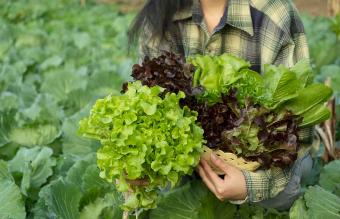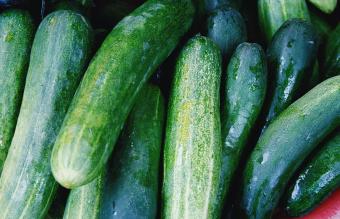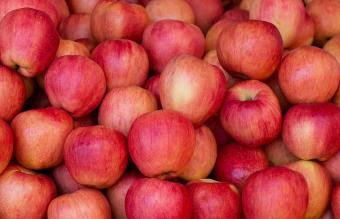
Fastest-growing fruits and vegetables can help you get a quick producing garden or orchard. Take into consideration if you're growing from seeds or buying plants.
Vegetables That Grow Quickly
Stay healthy and full by planting vegetables that have fast maturation.
Beets
Beets are one of the fastest-growing vegetables. Beets only require 55 to 70 days to mature.
- Plant in spring (mid-June harvest) and again in late July (fall harvest).
- You can plant successive crops a week apart for bigger production.
- Don't toss the leaves, since you can cook them as greens.

Cucumbers
Cucumbers are best grown vertically in full sunlight. The cucumbers will mature in 50 to 70 days, depending on the variety.
- Pick cucumbers before fully grown for best flavor and crispness.
- Harvest cucumbers daily since they grow very quickly
- If produce slows down, feed three tablespoons of Epsom salt sprinkled on ground to encircle the plant base. Leave about three inches between plant and Epsom salt.

Green Beans
Green beans can be grown as a bush or pole bean. Pole beans will provide a higher yield as long as the temperatures remain below 98°F. Beans will temporarily stop producing when the temperature becomes too high but will resume as soon as the temperatures lower.
- Make sure you check beans daily for harvesting once they get to about 45 days, since they grow very quickly.
- The more you harvest the more, they produce.
- Pole beans usually produce beans for a longer season than bush beans.

Lettuce
Leaf lettuce varieties and butterhead lettuces are some of the fastest-growing vegetables you can grow. They only take 45 to 55 days to mature. However, you can harvest any time.
- Young leaves are edible and pack greater taste and nutrition.
- You will harvest the outer leaves first to allow the plant to continue to produce leaves.
- While most lettuces prefer spring to early summer and late summer to fall weather, some varieties are slow bolting.
- You can grow lettuce year-round indoors as long as the plants receive adequate light up to 10 hours (grow lights will help).

Okra
Okra is very easy to grow and a huge producer. It matures between 50-65 days.
- You want to leave at least two feet between the plants since they have a large spread.
- You can plant lettuce between each plant to protect the lettuce plants from harsh summer sun and heat.
- Harvesting okra daily will keep the plants producing.
- Don't allow the pods to grow larger than three -four inches long or they will be tough.

Green Onions
If you need a really fast-growing vegetable, opt for green onions. You can use container to grow these onions. Plant from seed or transplant onion sets. Green onions are mature in 20-30 days of planting the seeds.

Radishes
Radishes grow very quickly. Some varieties are ready to harvest with 22 days of planting while other varieties may take up to 70 days.
- Choose the quick growing variety and plant succession crops every one to two weeks to ensure you have an ongoing crop throughout the grow seasons.
- Grow radishes from early spring to mid-summer and again at the end of summer into fall.
- It doesn't require more than soil depth of eight inches to grow globe rashes making these great for containers inside.

Spinach
Spinach can be grown in spring and early summer and again in late summer and fall. It has a short maturation range of only 25-45 days. The New Zealand variety can be grown through hot summer days without bolting. Harvest leaves by cutting no more than two inches from the ground to encourage regrowth.

Tomatoes
While technically, a tomato is classified as a fruit, when it comes to cooking, it's treated as a vegetable. Tomatoes are easy to grow. Some only take 50 days to maturity, while other varieties require as much as 70 day. If you don't have time to grow from seed inside your home to transplant later, you can purchase plants. Transplanted tomato plants make for a faster harvest from the time you transplant them to fruiting.
- Encourage an abundant crop by using tomato organic fertilizer as side dressing two weeks after transplanting. When the first blooms appear, side-dress.
- When the first tomatoes fruit, apply another side-dress.
- When you harvest the first tomatoes, side-dress.
- Your plants shouldn't require any more fertilizer once the first tomatoes form.

Zucchini and Summer Squash
Zucchini and summer squash are very easy to grow. Both are extremely prolific producers, with Zucchini squash growing as much as two to three inches per day.
- Zucchini reaches maturity within 35-55 days of planting seeds.
- Summer squash reach maturity 40-55 days of planting seeds.
- Keep zucchini and squash picked daily to encourage the plants to continue to produce.

Fastest Growing Fruits
Berries are biologically a fruit, but most people think of berries and fruit as different types of food. Strawberries, blackberries and raspberries are some of the fastest-growing fruits. They produce the fastest fruiting the second year, compared to blueberries that can take three to five years before producing berries. Fruits generally take longer to mature than vegetables, but some are faster than others.
Strawberries
Strawberries will produce fruit the first year. However, gardeners know to pinch off any blossoms or fruits the first year to improve quality of taste and abundance for the following year.
- After the first year, you'll be able to enjoy the plant for 4-5 years.
- It's advisable to plant more strawberries each year so you always have berries.
- June-bearers produce the largest fruit, but only produce for one-two weeks.
- Ever-bearers produce three crops, late spring, summer, and early fall.
- Day-neutrals produce berries constantly during the season.

Raspberries
Raspberries won't produce until the second year. They are self-pollinating so you don't need two cultivars to produce berries. You can choose between red, black or purple berries. Yellow raspberries are technically red raspberries that don't produce red pigment.
- Some cultivars begin fruiting in June while others start producing in the fall.
- Plants will produce for 15 - 8 years.
- The raspberry canes live for two years.
- Most cultivars will produce berries all summer.

Blackberries
The first year is mostly cane growth, although you may have a few berries. The second year, the berries form of the canes produced the previous year. Each cane survives for two years. You need at least two different cultivars for pollination.

Apples and Peaches
Apple and peach trees will take three to four years to start bearing fruit, depending on the variety. You can purchase three-year-old trees but expect to pay more. Grafts will produce much quicker than seedlings (grown from seeds).
- Apples will require two different varieties for your trees to pollinate.
- Like apples, most pears requires two different varieties to pollinate.
- Unlike apples and pears, peaches are self-pollinating and don't require a different variety to pollinate. If you wish a bigger crop, plant two different varieties so they'll cross-pollinate.

Citrus Fruits
Dwarf or grafted citrus trees can bear fruit the first year. You can try growing lemons, limes and oranges if you live in a tropical regional. If you live where the winters are cold or harsh, you can still enjoy growing lemons. Opt for a Meyer lemon tree and plant in a container you can move inside during the harsh winter months. Use a rolling trolley for easier movement in and out of your home.

Bananas
Bananas aren't biologically a fruit, but a perennial herb. It takes 10 to 15 months for the stalks to grow with the fruit requiring nine months. At the end of the season, you'll cut back the stalks allowing shoots to emerge and start the process over. The stalks grow between 2 and 12 feet high. If you prefer, you can grow bananas in containers. Containers allow you to take the plants inside during harsh winters, as long as you have the space inside your home. You can return the bananas outside once warm weather returns.

Discover What Fruits and Vegetables Grow Quickly
When you discover what fruits and vegetables grow quickly in your region, you can start planning a family summer vegetable garden. Choose fruits and vegetables your family enjoys and plant enough for everyone to enjoy.







